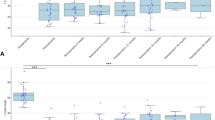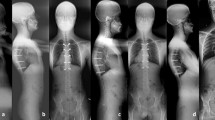Abstract
The use of computed tomography and developments in spinal biomechanics have led to a better understanding of vertebral fractures. The disappointing results achieved with conservative treatment have led to an increasing popularity of surgical treatment in the last 15 years. The results of 20 unstable thoracic or lumbar spine fractures treated surgically with Cotrel-Dubousset instrumentation at the First Clinic of Orthopaedics and Traumatology of the Ankara Social Security Hospital between December 1988 and June 1991 were evaluated in this study. The mean follow-up was 31.9 months. The mean sagittal index angle was 23.7° ± 6.8° preoperatively and was corrected by 67.1 ± 29.9%, and the thoracolumbar junction angle was brought within physiological limits in 65% of the cases. Postoperatively, the neurological status improved in 15% of the patients and remained unchanged in the rest. It was concluded that the Cotrel-Dubousset instrumentation established vertebral stability in unstable vertebral fractures by forming a rigid frame and restored physiological thoracic and lumbar postural contours due to its highly corrective effect in the sagittal plane.
Similar content being viewed by others
References
Akbarnia BA, Moskowicz A, Merenda JT et al (1990) Surgical treatment of thoracic spine fractures with Cotrel-Dubousset instrumentation. 7th International Congress on Cotrel-Dubousset Instrumentation, Sauramps Medical, Montpellier, p 7
An HS, Vaccaro A, Cotler JM et al (1991) Low lumbar burst fractures. Comparison among body cast, Harrington Rod, Luque Rod and Steffee Plate. Spine 16 [Suppl 8]:4401–441
Argenson C, Lovet J, Cambas PM et al (1989) Osteosynthesis of thoracolumbar spine fractures with Cotrel-Dubousset instrumentation. 6th International Congress on Cotrel-Dubousset Instrumentation. Sauramps Medical, Montpellier, p 9
Ashman RB, Birch JG et al (1988) Mechanical testing of spinal instrumentation. Clin Orthop 227:113–125
Atlas SW, Regenbogen V, Rogers LF et al (1986) The radiographic characterization of burst fractures of the spine. AJR 147:575–582
Bauer RD, Errico TJ (1991) Thoracolumbar spine injuries. In: Errico JJ, Bauer RD, Waugh T (eds) Lippincott, Philadelphia, pp 911–957
Denis F (1984) Spinal instability as defined by the three-column spine concept in acute spinal trauma. Clin Orthop 189:65–79
Denis F, Winter RB, Lonstein JE (1989) CD superiority in the treatment of fracture dislocations of the thoracic and lumbar spine. 6th International Congress on Cotrel-Dubousset Instrumentation. Sauramps Medical, Montpellier, p 11
Dick W (1987) The “Fixateur Interne” as a versatile implant for spine surgery. Spine 12:882–900
Dickson JH, Harrington PR, Ervin WD (1978) Results of reduction and stabilization of the severely fractured thoracic and lumbar spine. J Bone Joint Surg [Am] 6:799–805
Fabris D, Vigliani F (1989) Different CD assemblies for thoracic, thoracolumbar and lumbar fractures. 6th International Congress on Cotrel-Dubousset Instrumentation. Sauramps Medical, Montpellier, p 10
Farcy JPC, Weidenbaum M, Glassman SD (1990) Sagittal index in management of thoracolumbar burst fractures. Spine 15:958–965
Frankel HL, Hancock DO, Hyslop G, et al (1969) The value of postural reduction in the initial management of closed injuries of the spine with paraplegia and tetraplegia. Paraplegia 7:179–192
Gurr KR, McAfee PC, Shih CM (1987) Biomechanical analysis of posterior instrumentation systems following decompressive laminectomy. An unstable calf spine model. 4th Proceedings. Sauramps Medical, Montpellier, p 119–133
Johnston CE II, Ashman TB, Sherman MC et al (1987) Mechanical consequences of rod contouring and residual scoliosis in sublaminar segmental instrumentation. J Orthop Res 5:206–213
Kostuik JP (1984) Anterior fixation for fractures of the thoracic and lumbar spine with or without neurologic involvement. Clin Orthop 180:103–115
Montesano PX, Benson DR (1992) Fractures and dislocations of the spine. The thoracolumbar spine. In: Rockwood CA Jr, Green DT, Bucholls RW (eds) Rockwood and Green's fractures in adults, 3rd edn. Lippincott, Philadelphia, pp 1358–1392
Weidenbaum M, Farcy JPC (1991) Surgical management of thoracic and lumbar burst fractures. In: Bridwell KH, De Wald RL (eds) The textbook of spinal surgery. Lippincott, Philadelphia, pp 911–957
Wenger DR, Carollo JJ (1984) The mechanics of thoracolumbar fractures stabilized by segmental fixation. Clin Orthop 189:89–96
Wilber RG, Thompson GH, Schuffer JW, et al (1984) Postoperative neurological deficits in segmental spinal instrumentation. J Bone Joint Surg [Am] 66:175–187
Author information
Authors and Affiliations
Rights and permissions
About this article
Cite this article
Benli, I.T., Tandoğan, N.R., Kiş, M. et al. Cotrel-Dubousset instrumentation in the treatment of unstable thoracic and lumbar spine fractures. Arch Orthop Trauma Surg 113, 86–92 (1994). https://doi.org/10.1007/BF00572912
Issue Date:
DOI: https://doi.org/10.1007/BF00572912




